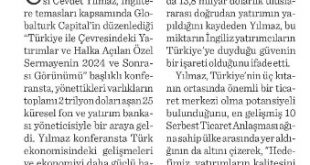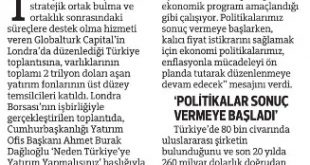More than 2,000 global private equity & venture capital professionals gathered in Berlin for three days to discuss the current critical issues in PE industry. Live coverage from panels were broadcasted and insights from attendees were received. The main highlights were as follows;
- The implications of “new world order” implied by Brexit, China’s Falling Domestic Equity Markets, US Elections on the global economy, liquidity and PE investing are confusing. On the other hand, the liquidity is at historically record high levels and the purchase price multiples are high. Abundant liquidity is healthy for the business. The US market ran up significantly in the election in Post Trump era, yet the signals on regulatory issues are diverse from different perspectives; positive from growth perspective, and negative from foreign policy perspective likely to put pressure on global growth. The anti-trade populism rose in 2016 during USA election campaign. USA is financially in a better shape thanks to strong domestic business conditions while the uncertainties, such as Brexit, are bigger on the European side. The deal activity already slowed down in UK as a result of Brexit while accelerated in continental Europe. Nevertheless; Brexit is still at its infancy and 12 to 18 months are required to understand its implications better. It is yet to be seen whether it is going to be a soft Brexit, or a hard Brexit. And the biggest risk lies in European elections and not in the US-China tensions. There no major worrisome issues on the regulatory side. It is important to note that the PE industry is capable of coping with all eco-political cycles, hence it can make money in every cycle. Furthermore, the PE industry has a long investment horizon of 5 to 10 years.
- What are the key themes in the PE industry? From valuation perspective, exits with higher multiples is unlikely to reside going forward and PEs need to work harder to find growing companies to invest in. The most common theme in PE industry is currently “consolidation”. PEs may act as strategic investors, buying two companies at the same time for example. PEs have grown to know industries and they are able to do platform investments. Recently, LPs increased interest of going direct and there is a segmentation of deals where companies are partnering with LPs. The need for longer deals is rising in order to use the abundance of capital (i.e. more than 1 trillion dollar) since there is a shortage of deal supply. The dynamics of LP-GP relationship are shifting. The LPs are more involved in direct investing. LPs tend to deal with GPs in closer relationship.
- Further growth is to stem from consumption growth in growth markets as well as innovation and productivity. There are three important Cs; commodity, consumption China. China is shifting its economy from investment to consumption following fifteen years’ of high growth. Jakarta, Istanbul and Mexico City have huge growth potentials thanks to their young population. Unilever, Nestle, P&G etc. are getting 3/4ths of their growth from these growth markets. Global growth markets generate 2/3rd of global GDP and 3/4th of global growth. As a result, 470 billion $ worth of approximately 2,300 deals happened in these markets (excluding China). Going forward, it is likely that a lot of south-south trades will take place. Commodity price booms, which will boost growth further, have not materialized yet. It is more helpful to look at each growth country individually, rather than clustering them in groups. India and China have very little in common for example even though they are combined within BRIC. It is also noted that when there is a real risk, it usually comes from the West (i.e. Lehman crises). On the other hand, changes in disruptive technologies and humanlike functionalities in robotics pose a great growth opportunity.
- What are the new themes in the PE industry? 2016 was generally slow in terms of investment activity. There is a need to come up with an edge and a good new asset class is created – private debt (private credit). It is a private equity style credit deployment where 13% IRRs can be created. IPO market isn’t really there for exits. It used to be 50-50% IPO – M&A exits in the past, lately 2/3rd of exits are M&A exits. It is a good signal that the strategic buyers are bullish. Strategic buyers benefit from PE investors. New types of buyers are emerging buyers such as Chinese, Japanese or Asian in general.
- There is a huge demand for infrastructure investments and significant amount of money (i.e. 4 billion USD) is raised for this purpose. Private debt could be great for infrastructure investments, yet there are only a few experienced people in infrastructure in the industry and the governance level is low. Private debt seems to have a good risk reward balance. Illiquid credit-sponsored lending, structured credit and asset based lending are expected to grow. Valuations are attractive in China, India and South East Asia.
- Fund raising levels are back at pre-crisis levels; around 475 billion USD in 2015 and more than 250 billion USD in the first six months of 2016. PE industry is maturing, small family offices to pension funds act like PEs. There is also a growing appetite for LPs to co-invest. There are always higher returns in the PE asset class as compared to public equities. Higher valuations and lower returns may evoke concern since there is so much dry powder (money) in the market which drives valuations up.
- What makes lower to mid-market so attractive? There are plenty of opportunities (100-150 a year and 2-4 deals are done) in this segment thanks to i) unusual business models, ii) faster growth in a shorter period of time and iii) plenty exit opportunities. LPs have control on companies. Potential risks are related to the quality of management and competitive forces from larger companies.
- Growth Industries: In terms of geographic location highest returns are generated in NA (46%) and Asia (22%). Top four sectors are; technology (40%), healthcare (20%), financial and bus services (12%), and infrastructure (12%). Co-investment is usually preferred since it is new and free. However, the deal quality may suffer in most cases and also the time frame is shorter as compared to a fund. Hence, some LPs actually don’t do co-investments due to their drawbacks.
- Issues to Watch: Changes to the interest deductibility (31%), Brexit (25%), potential US tax reform (16%) are biggest threats in the PE industry. On the other hand, biggest cause of friction between LPs and GPs are; fees (48%), performance (21%), transparency (17%). The public image of the industry is poor but improving (36%), adequate (33%), good (20%). More data needs to be shared on employment creation since the industry is doing well from that point of view. Also, more diverse backgrounds are coming to the industry.
 Barış Öney Barış Öney'in Kişisel Web Sitesidir.
Barış Öney Barış Öney'in Kişisel Web Sitesidir.









